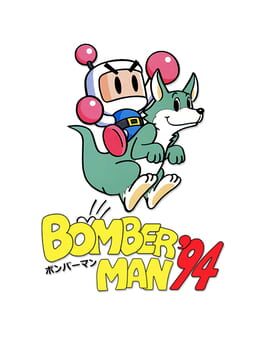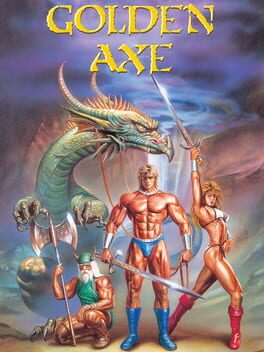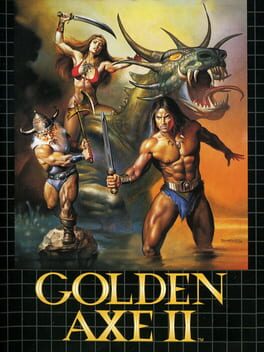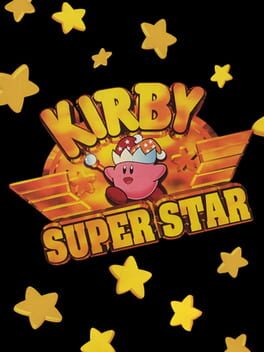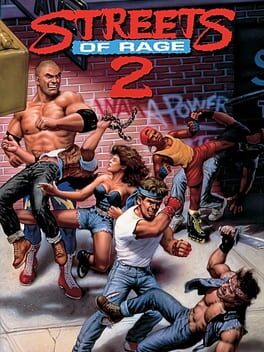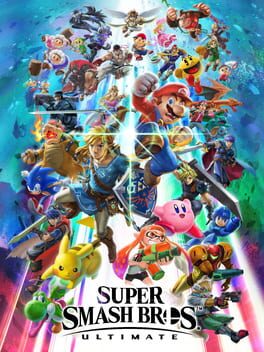madyson
1993
The most accessible of Bomberman's 16-bit escapades, 94 de-emphasizes the arcade side of the franchise's gameplay loop. The minute differences in structure and level design make powerups less significant, and thus there's less penalty for losing them. Couple that with fewer stages, Louies for extra health and abilities, and you have a Bomberman game that is one parts more comfort food-y, another part somewhat gentrified. The more chaotic side of the formula gets muffled hard.
Of the two ports, avoid Mega Bomberman. Slowdown makes the latter half of that game's campaign nigh unplayable - a shame, since it arguably has the better soundtrack.
Of the two ports, avoid Mega Bomberman. Slowdown makes the latter half of that game's campaign nigh unplayable - a shame, since it arguably has the better soundtrack.
Kirby's best combat and environmental stage design stuffed inside Nintendo's trademarked 'do-things-get-dopamine' skinner box. With the addition of a Z axis and bossfights with dynamic camera framing mechanisms and more organic, complex attack formations, Kirby has reached a zenith that puts it extremely close to the likes of DMC and Bayonetta - he even has witch time.
The rest of the content that populates the game is thoughtless busywork strung together by flaccid hallways. Forgotten Land doesn't really know how to balance out the relationship between its platforming flow and enemy encounters, most evident by the treatment of copy abilities. 2D Kirby's formula cemented Copy Abilities as primarily combat tools that could also be utilized for movement tech; almost every ability had some way to provide additional horizontal or vertical distance, and in turn, level hazards and enemy placement was modeled around multiple forms of attack-propelled velocity. Large move pools were necessary not just for player expression and empowerment, but so that players had a way to get themselves around faster - and if not, at least a way to deal damage without stopping in place. These have been all but stripped away in FL, leaving abilities in their place that feel compromised both for platforming and combat.
By the third world, Forgotten Land's gameplay flow becomes cyclical to the point of feeling predatory. The feeling of discovery and imagination that hooks the first few worlds wears off. The rest of the experience just feels like 'going through the motions' until you finally get to the bosses, the final stage, and later unlock the arenas. It's only the promise of stronger copy abilities, new lore tidbits and setpiece-driven moments that keeps this from being an otherwise mundane slog. HAL's innovations are commendable, but they forgot their own franchise's hallmarks along the way, leading to a game with the franchise's highest highs populating an indistinguishable clone of Mario's most boring foundations. The sequel needs to straight-up be an action game, no filler.
The rest of the content that populates the game is thoughtless busywork strung together by flaccid hallways. Forgotten Land doesn't really know how to balance out the relationship between its platforming flow and enemy encounters, most evident by the treatment of copy abilities. 2D Kirby's formula cemented Copy Abilities as primarily combat tools that could also be utilized for movement tech; almost every ability had some way to provide additional horizontal or vertical distance, and in turn, level hazards and enemy placement was modeled around multiple forms of attack-propelled velocity. Large move pools were necessary not just for player expression and empowerment, but so that players had a way to get themselves around faster - and if not, at least a way to deal damage without stopping in place. These have been all but stripped away in FL, leaving abilities in their place that feel compromised both for platforming and combat.
By the third world, Forgotten Land's gameplay flow becomes cyclical to the point of feeling predatory. The feeling of discovery and imagination that hooks the first few worlds wears off. The rest of the experience just feels like 'going through the motions' until you finally get to the bosses, the final stage, and later unlock the arenas. It's only the promise of stronger copy abilities, new lore tidbits and setpiece-driven moments that keeps this from being an otherwise mundane slog. HAL's innovations are commendable, but they forgot their own franchise's hallmarks along the way, leading to a game with the franchise's highest highs populating an indistinguishable clone of Mario's most boring foundations. The sequel needs to straight-up be an action game, no filler.
1991
1989
1991
Golden Axe and Streets of Rage represented two sides of the same brawler coin for Sega in the 90's: The garish, tactless Conan-derivative beat-em-up with sloppy mechanics held together by senseless guilty pleasures, and the suave, snappy Fight Fight clone with a more soulful take on the sights and sounds that defined the mold. Hindsight hasn't been as kind to Golden Axe as it has to good ol' SoR, but the nuances were probably a lot harder to see at the time. You'd be justified in saying each respective entry in their trilogy was doing their best for their time.
When the Sonic bucks started rolling in, it came to stand that Sega's other IP's deserved another shake with further passion and budget. Streets of Rage 2 enriched every idea from its predecessor, bringing the visuals up to the same pristine fidelity that anointed its SNES nay-sayers alongside expansions and refinement to the pre-existing format. It was everything a sequel should be - respecting the original while acknowledging the need to innovate.
Golden Axe II, released a year prior, was not so lucky. Its changes largely superficial, its improvements limited to extremely subtle differences in gamefeel, and its content and scope just as limited as the original. If anything, II's failure to innovate makes it come across as the weaker of the two, being 2 years older but retaining the original's issue of feeling like something is amiss. While Sega would later have the chance to right their wrongs with the arcade-exclusive Revenge of Death Adder, console owners would remain stuck in tunnel vision as the Genesis Golden Axe games failed to mature while their contemporaries graduated and moved on to bigger and better things.
When the Sonic bucks started rolling in, it came to stand that Sega's other IP's deserved another shake with further passion and budget. Streets of Rage 2 enriched every idea from its predecessor, bringing the visuals up to the same pristine fidelity that anointed its SNES nay-sayers alongside expansions and refinement to the pre-existing format. It was everything a sequel should be - respecting the original while acknowledging the need to innovate.
Golden Axe II, released a year prior, was not so lucky. Its changes largely superficial, its improvements limited to extremely subtle differences in gamefeel, and its content and scope just as limited as the original. If anything, II's failure to innovate makes it come across as the weaker of the two, being 2 years older but retaining the original's issue of feeling like something is amiss. While Sega would later have the chance to right their wrongs with the arcade-exclusive Revenge of Death Adder, console owners would remain stuck in tunnel vision as the Genesis Golden Axe games failed to mature while their contemporaries graduated and moved on to bigger and better things.
1996
Kirby as a franchise has always been the pinnacle of Nintendo's best design traits with none of the bad. There's no secret magic or player psychology going on here, it's just six fun little campaigns with a cute dude that you can play with a pal. The difficulty's perfect, basically never punishing you except slowing you down - in turn, rewarding skill with speed and interruptionless flow. The music's delightfully playful but still goes hard when it wants you to take a fight seriously. Copy abilities are still one of the greatest gameplay ideas known to man, you just swooce a dude and now you have a whole ass Street Fighter character's worth of moves at your disposal. And while the rest of Nintendo's big name brands have struggled to make anything resembling a good boss fight, Kirby Super Star is out there throwing over a dozen at you and they all kick ass. There's none of this 'hit them three times to expose a weak point' or 'stop attacking to dodge this screen sweep' bullshit, it's just a cool-looking dude throwing cool attacks out and there's nothing stopping you from pummeling them other than the odds you might get it. Whoop their ass with your fuckin' giant ass hammer uppercut, Bonkers.
There's a lot of copy-and-pasting and re-used content in order to pad out the experience to a full six campaigns, but this is one of the few games where it's a welcomed cop-out. I'm gonna take more Kirby any day of the week, even if it's just remixed versions of the levels I already did it's gonna be a treat. And that's nothing to say of just how impressive it is that everything here fits on a 2.6 megabyte rom.
Po goddamn yo, motherfucker
There's a lot of copy-and-pasting and re-used content in order to pad out the experience to a full six campaigns, but this is one of the few games where it's a welcomed cop-out. I'm gonna take more Kirby any day of the week, even if it's just remixed versions of the levels I already did it's gonna be a treat. And that's nothing to say of just how impressive it is that everything here fits on a 2.6 megabyte rom.
Po goddamn yo, motherfucker
1992
SoR2 already has a firmly established reputation as a beat-em-up posterchild, and there's not much more to be said about it. The difficulty curve is perfect, the combat feels just right, the AI design and intentionally tankish movement brings out the cautious and mindgame-driven side of brawler design, and its soundtrack forever remains a Genesis hallmark. But beyond all the immediate bullet points, SoR2 deserves an audience because it sets out to bring humanity and soul to a genre often stereotyped as mindless junk food.
What sets SoR2 apart in the spectrum of brawlers is its ability to invigorate its universe with authentic life - especially when compared to its arcade forefathers. In Double Dragon's iconic intro, you watch Marion get an unprompted punch to the gut as she's carried off by a gaggle of thugly caricatures. In Final Fight, the first enemy you see is the mad crook Damn'd, having kidnapped and stripped Haggar's daughter - treating her like a dehumanized pawn for bartering. The ten dozen different versions of TMNT all have Shredder and Krang snatching away the Statue of Liberty (horrors!). All of these games - along with most brawlers of the time, - use these framing choices to establish from the get-go that your enemies are one-dimensional cronies that exist to beat or be beaten. They're ugly, brutish, no-good punching bags, and sometimes just downright outdated stereotypes.
You could say SoR's no better with how it also features a kidnapping plot and lots of borrowed enemy tropes from Final Fight and such, but it's not so forceful or tactless about it, and it's just a single element in its larger setting of government corruption and fractured city life. SoR2 is still a video game of its time and is incredibly fictionalized, but by overall contrast, there's a greater attempt to paint enemies as people beyond their circumstances. All the generic foes have casual, lived-in fashion styles, and many are depicted DOING things in their downtime - sleeping on park benches, chilling at an arcade, waiting for a drink at the bar, and such. They're as much a part of the setting as the leering streetlights and flashing neon signage are. Further compounded by SoR's brilliant environmental art, creating lived-in worlds with moody colors, delicate space and facsimiles of nostalgic real-world locales. It feels like a fictionalized slice of reality, just playing by some of its own stylistic rules. Yuzo Koshiro's music is equally responsible for this ambiance through his ability to steal but never outright ripoff popular house beats and melodies - the ingredients of reality shine through the simulation.
Streets of Rage 2 is fantastic and remains a divergent slice of the 4th gen beat-em-up pie, singing a similar tune as the rest of the crowd but putting a bit of heart into it. You could walk away feeling that it's just an hour of drop-kicking chumps, but it's a SOULFUL hour of drop-kicking chumps, dammit.
What sets SoR2 apart in the spectrum of brawlers is its ability to invigorate its universe with authentic life - especially when compared to its arcade forefathers. In Double Dragon's iconic intro, you watch Marion get an unprompted punch to the gut as she's carried off by a gaggle of thugly caricatures. In Final Fight, the first enemy you see is the mad crook Damn'd, having kidnapped and stripped Haggar's daughter - treating her like a dehumanized pawn for bartering. The ten dozen different versions of TMNT all have Shredder and Krang snatching away the Statue of Liberty (horrors!). All of these games - along with most brawlers of the time, - use these framing choices to establish from the get-go that your enemies are one-dimensional cronies that exist to beat or be beaten. They're ugly, brutish, no-good punching bags, and sometimes just downright outdated stereotypes.
You could say SoR's no better with how it also features a kidnapping plot and lots of borrowed enemy tropes from Final Fight and such, but it's not so forceful or tactless about it, and it's just a single element in its larger setting of government corruption and fractured city life. SoR2 is still a video game of its time and is incredibly fictionalized, but by overall contrast, there's a greater attempt to paint enemies as people beyond their circumstances. All the generic foes have casual, lived-in fashion styles, and many are depicted DOING things in their downtime - sleeping on park benches, chilling at an arcade, waiting for a drink at the bar, and such. They're as much a part of the setting as the leering streetlights and flashing neon signage are. Further compounded by SoR's brilliant environmental art, creating lived-in worlds with moody colors, delicate space and facsimiles of nostalgic real-world locales. It feels like a fictionalized slice of reality, just playing by some of its own stylistic rules. Yuzo Koshiro's music is equally responsible for this ambiance through his ability to steal but never outright ripoff popular house beats and melodies - the ingredients of reality shine through the simulation.
Streets of Rage 2 is fantastic and remains a divergent slice of the 4th gen beat-em-up pie, singing a similar tune as the rest of the crowd but putting a bit of heart into it. You could walk away feeling that it's just an hour of drop-kicking chumps, but it's a SOULFUL hour of drop-kicking chumps, dammit.
